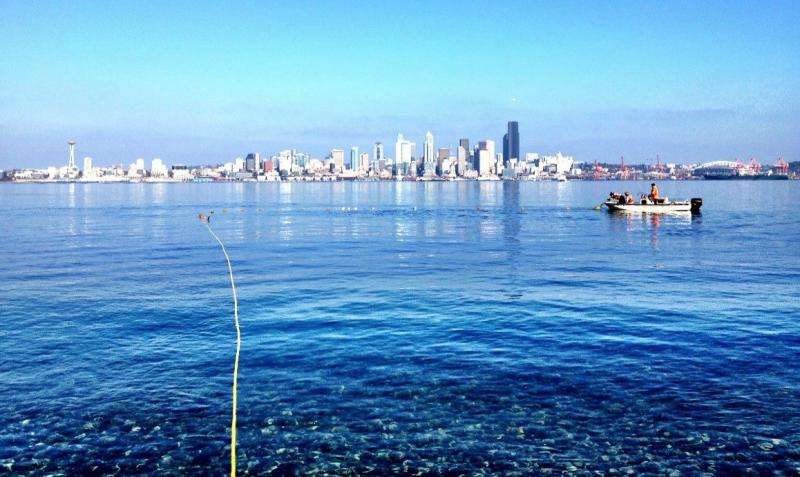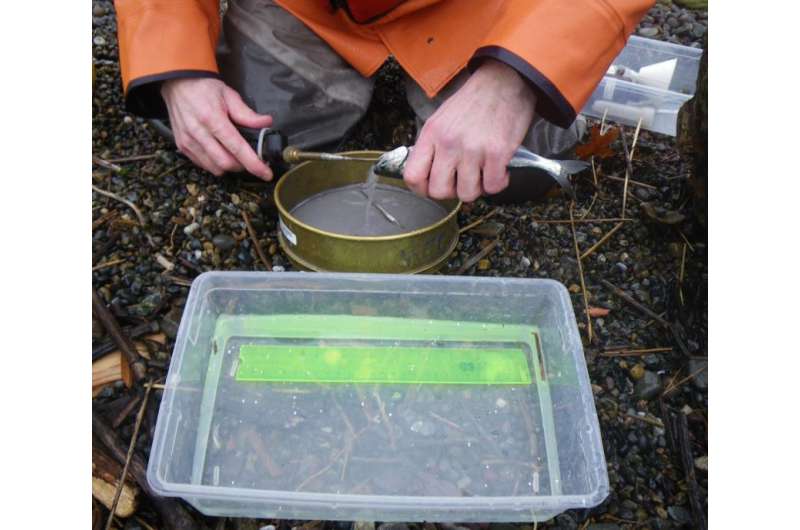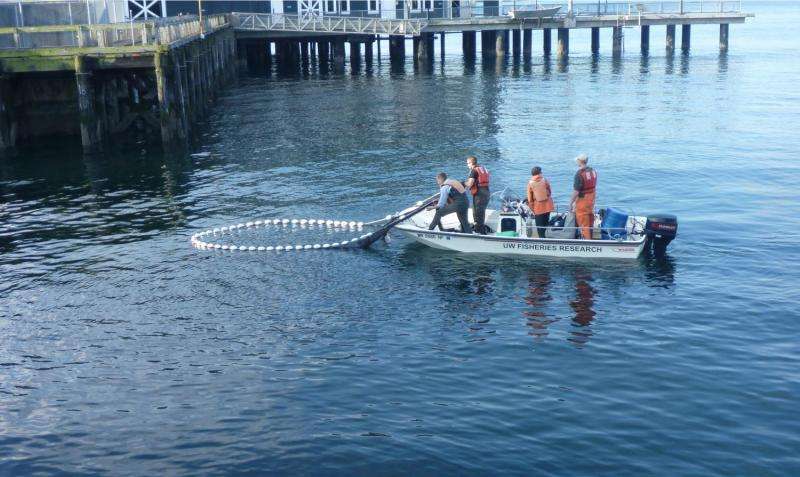Young chum salmon may get biggest nutrition boost from Elliott Bay restored beaches

In the midst of ferry boats, container ships and tourists crowding Seattle's Elliott Bay, young salmon are just trying to get a decent meal.
The fish hatch in the rivers and streams that feed into Puget Sound and almost immediately rely on eating small organisms near the shore, including in the heart of Seattle's commerce-filled waterfront.
Though salmon share the busy Elliott Bay waters with boats and barges, scientists suspect built-up, "armored" shorelines and large piers may be the main culprits disrupting fish habitat. These artificial structures block light and confuse the fish as they make their way to the ocean.
But are concrete seawalls actually affecting what the salmon eat, and by how much? A University of Washington study shows that it depends on the species, with small chum salmon seeming to be most affected.
The study looked at the diets of young salmon passing through Elliott Bay. Researchers measured the types of prey in the water along armored shorelines and along restored beaches. Scientists then collected young salmon in nets—corralled by boats or divers—and flushed out their stomachs to look at what they ate recently.
The stomach contents showed that young pink and Chinook salmon that feed on organisms either floating in the water or on the water's surface were able to eat the same amount of food, whether they were feeding near a concrete shoreline such as Seattle's ferry terminal at Coleman Dock or along shoreline that has been restored to look like a natural beach, including along Seattle Art Museum's Olympic Sculpture Park.

However, young chum salmon that munch on critters found mainly in bottom habitats had a noticeable change in their eating patterns depending on the type of shoreline. These small chum salmon ate more invertebrates floating in the water when swimming by armored sites, and more bottom-dwelling crustaceans—which they prefer—when feeding near beaches. Larger juvenile chum behaved more like their pink and Chinook counterparts.
"Our study shows that armoring affects what species of prey are available," said lead author Stuart Munsch, a UW doctoral student in aquatic and fishery sciences. "Fish that normally eat those missing prey will feed on alternative species at armored sites, but we don't know what the costs of that change are to the fish."
The findings were published Sept. 15 in the journal Marine Ecology Progress Series.
The article details the latest in a series of recent studies along Seattle's waterfront that is trying to better understand how fish behave in urban, industrial waterways. The shores of Elliott Bay are almost fully walled-in with concrete and riprap, a layer of large stones designed to keep soil from eroding. The most natural shorelines are along several manmade sandy beaches, restored recently for public recreation and natural beauty.
The study confirmed that areas converted to look like beaches attract more diverse organisms, including small crustaceans known as harpacticoid copepods. These weren't seen much along armored shorelines, which instead had more barnacles—not an appetizing choice for young salmon.
"Engineered shorelines like these manmade beaches are going to have more components of a natural ecosystem than a featureless wall," said co-author Jeff Cordell, lead investigator on the project and a UW research scientist with aquatic and fishery sciences. "Manmade beaches will produce more diversity and numbers of the kinds of food juvenile salmon utilize."

The researchers found that while the types of organisms in the water did indeed change depending on shoreline, only the small chum salmon actually adjusted what they ate.
Maybe the other fish, the pink, Chinook and larger chum salmon, ate prey that wasn't directly affected by the type of shorelines present—such as plankton, which was in the water at both locations—or were large and strong enough to swim through both areas, eating along the way, before their stomach contents were measured.
But small chum salmon are especially dependent on the tiny crustaceans more common along restored beach sites. And while none of the fish studied were starving, the fish whose diets changed may have used up considerable energy trying to keep a balanced diet.
"The [type of] copepods that chum salmon usually feed on are brightly colored and they're found near the bottom," Munsch said. In other words, the chum's typical diet is easy prey. "We think that chum salmon along armored shorelines might have to spend more energy searching for prey that are harder to see, or chasing prey that are more evasive, when that energy should be allocated to growth or migration."
This study and other recent papers by Cordell's research team are informing Seattle's Seawall Project, which is replacing the current waterfront wall with a structure that intends to be friendlier to fish while protecting city infrastructure.
Journal information: Marine Ecology Progress Series
Provided by University of Washington



















